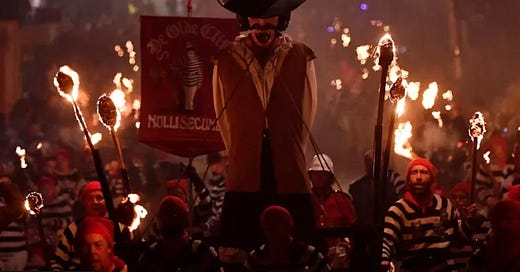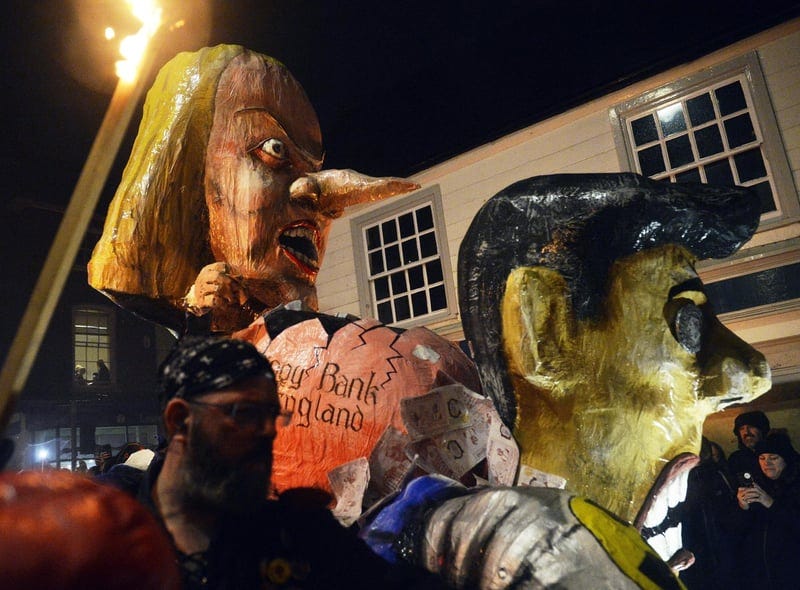Bonfire Night: Celebrating Parliament's Rescue
Four centuries after a guy named Guy Fawkes nearly burned down Parliament, both U.S. and U.K. politicians have a lot at stake
Bonfire Night in Lewes (pronounced Lewis), England, where an large effigy of Guy Fawkes is led through the streets before being set on fire.
Dearest friends and fellow country(wo)men,
It seems that the British like nothing better than to blame the Americans for the evolving prominence of Halloween in their country. Apparently, some years ago, despite the pagan recognition of All Souls Day and the Church of England’s celebration of All Saints Day, it was never a custom for children to don “fancy dress” (the British term for costume) and go door-to-door to beg for candy.
Leave it to us to commercialise it and spread it to the UK, however.
Yet, the cultural exchange has not gone both ways, for one of the country’s biggest nights — Bonfire Night, aka Guy Fawkes Night — is hardly known in America. But Guy Fawkes Night could become the Next Big Thing in the States, for just two short years ago, a bunch of anti-government types attempted to take down the government in a similar manner to this early 17th-century villain.
TheVillain-in-Chief burned in effigy in several forms during the 2022 Bonfire night was former Prime Minister Liz Truss, who lasted 45 days in office — the shortest term in English History.
Observed in the United Kingdom every year on 5 November, Guy Fawkes Night commemorates a failed assassination attempt from over 400 years ago. On November 5, 1605, Guy Fawkes, a former crusader from York, and a group of radical English Catholics tried to blow up Parliament with King James II inside. Why? The reign of Queen Elizabeth I, whose father, Henry VIII left the Catholic church and created the Church of England, had left Catholics brutally suppressed: they could not legally celebrate Mass, receive their rites of baptism, communion or marriage or consult priests, many of whom were put to death.
After King James I, daughter of Mary Queen of Scots, married a Catholic and the throne upon Elizabeth’s death in 1603, Catholics believed the oppression would end and that maybe James himself would become Catholic.
He didn’t. In fact, he ordered all Catholics to leave England. They didn’t.
An effigy of Liz Truss robbing the Bank of England while sitting on top of current Prime Minister Rishi Sunak makes its way down the main streets of Lewes, England for the 2022 Bonfire Night parade.
Having attempted several failed conspiracies against Elizabeth I and James, Fawkes, who had recently returned from Spain (calling himself Guido), enlisted a handful of Catholic dissidents and together, they came up with a plan to blow up the Houses of Parliament with gunpowder. On the night of 5 November 1605 when King James I and his eldest son would open a new session of Parliament, they would set fire to the barrels and blow the Houses of Lords and Commons to rubble. In the meantime, his co-conspirators would start an uprising in the English Midlands, kidnap James’ daughter Elizabeth, install her as a puppet queen and eventually marry her off to a Catholic, thereby restoring the Catholic monarchy.
Various bonfire societies donning traditional costumes celebrate the late Queen.
There was a mole in the ranks, however, and a search party found Fawkes hiding out in his cellar on the night of 4 November with matches in his pocket and 36 barrels of gunpowder stacked about. Fawkes was taken to the Tower of London and tortured upon the special order of King James. Soon after, his co-conspirators were also arrested. All were found guilty of high treason and sentenced to death in January 1606 by hanging, drawing and quartering. Catholics were not fully emancipated in England until the 19th century.
Soon after the executions, an act of Parliament designated 5 November as a “day of thanksgiving.” Guy Fawkes Day festivities soon arrived on the shores of the American colonies, where they became known as Pope Day, as British subjects on both sides of the Atlantic burned an effigy of the supreme pontiff. By the 19th century, however, no one in the States ccared about Guy Fawkes Day, but in England, families gathered, lit bonfires and watched parades, as well as burned effigies of Fawkes — or in later years, any political leader that had fallen out of favour. Children traditionally wheeled around their large burning puppets while demanding a “penny for the Guy” and imploring crowds to “remember, remember the fifth of November.”
Other bonfire societies hew more to the origins of Bonfire Night and commemorate the Catholic martyrs of the « Gunpowder Plot. »
Since the 20th Century, Guy Fawkes has undergone a bit of a makeover, portrayed in some circles as a revolutionary hero — rather than a traitor — largely due the 1980s graphic novel and 2005 movie “V for Vendetta,” which depicted a protagonist in a Guy Fawkes mask battling a fascist government in Britain. Guy Fawkes masks also appeared on the faces of protestors during Occupy Wall Street and at the World Economic Forum. Historians largely agree that every generation reinvents Guy Fawkes to suit their needs.
Newcomers to the UK might think Bonfire parades would jam up the streets of London, but most of them take place in the East Sussex town of Lewes. In fact, the Sussex Bonfire season actually starts on the first weekend of September and does not end until the third week of November. People form bonfire societies from towns all around Sussex and the western edges of Kent, help each other build effigies and participate in each other's parades, with the biggest nights attracting tens of thousands of people from around the country.
Russian President Vladimir Putin made an appearance as the devil in the 2022 Lewes Bonfire Nighg.
Lewes Bonfire Society puts on the largest bonfire night in the country, and thanks to the parade of costumes — ranging from World War One to the Battle of Waterloo (the most popular costume, and easiest, is that of the stripy sweatered smuggler) — outstanding effigies and fireworks, the market town's population of 18,000 quadruples. The seven bonfire societies carry burning barrels and 17 burning crosses to commemorate the 17 Protestant martyrs burnt at the stake in Lewes during the 16th-century reign of Bloody Mary. After the march, all of them gather at their designated pubs, which double as their official headquarters.
The main issues of the previous 12 months — U.S. Elections, Brexit, Russian interference, Scottish independence and Covid — dictate the figures chosen to be reconstructed in combustible material and set aflame. Recent celebrities chosen for the honour have included former prime ministers David Cameron, Teresa May, Boris Johnson; U.S. presidents Donald Trump and Joe Biden; world dictators Saddam Hussein, Vladimir Putin, and Kim Jong-Un; and football celebrities Sepp Blatter and Wayne Rooney.
In 2021, the parade focused less on politics and more on another societal scourge: the Covid-19 pandemic.
In 2021, this particular float shows Guy Fawkes as a pandemic doctor with a vaccine.
Guy Fawkes paraded down the streets of Lewes in 2021 as a patient receiving his Covid-19 vaccination.
Former Health Secretary Matt Hancock was a popular effigy for the Covid-themed 2021 parade.
Still, the age-old effigy of the Pope remains the most contentious. Lewes societies stress that the Pope effigy doesn’t symbolise the current Pope, but specifically Pope Paul V, who led the Catholic church during the burning of the 17 Protestant martyrs. But every now and then, a religious leader shows up at the non-Sectarian parade and makes a fuss. The next year, that person usually becomes one of the effigies.
An effigy of Boris Johnson and Jacob Rees-Mogg ride the Brexit roller-coaster during the 2021 parade through the streets of Lewes, East Sussex.
Many Bonfire nights burn the Pope in effigy, but this is specifically Pope Paul V from the 16th Century.
An effigy of North Korea leader Kim Jong-un was taken through the streets of Lewes by his nuclear minions during the 2018 parade.
Today, in the States, as the Biden administration braced itself for a bad night of midterm election results, former president Donald Trump prepared his second run for the White House and policies on guns and abortion threatened to divide the country into factions possibly not seen since the Civil War, the mood is beyond restive. Maybe instead of one party or the other storming the Capitol Building again, they can just form united groups, build some giant puppets and burn off some energy like the Brits.
Ever yours,
Adrian
Subscribe
If you enjoy this newsletter — and the photographs — I ask that you subscribe. Your small donation goes a long way toward my goal of what the English call “permanent leave to remain” and the Americans call “to stay in the country.”















